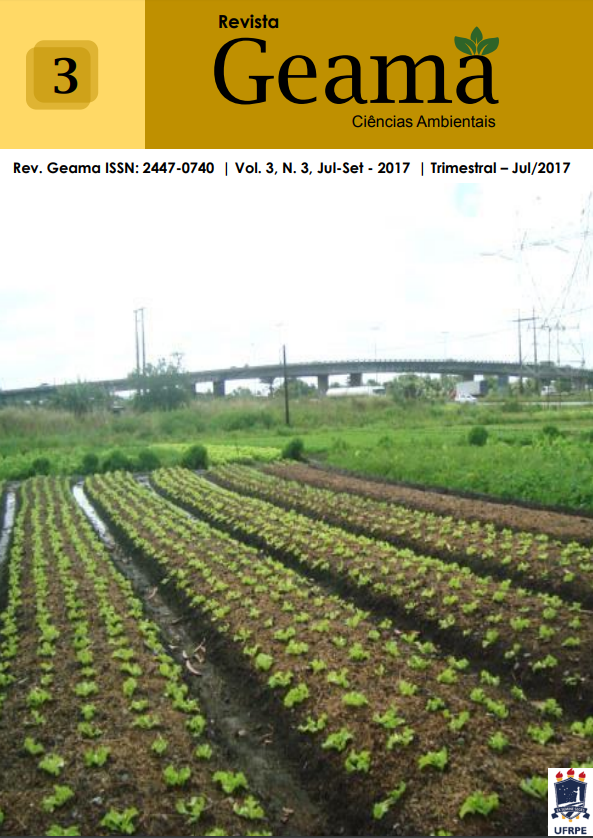Koppen-Geiger and Thornthwaite climatic classification for the metropolitan region of the Cariri, Ceará
Palavras-chave:
Climatology, Semiarid, Geoprocessing.Resumo
The aim of the present work was to compare the Koppen-Geiger and Thornthwaite methods for Climatic Classification of the Metropolitan Region of Cariri, state of Ceará, Brazil. The study area comprises the nine municipalities in the metropolitan region of the Cariri, being Juazeiro de Norte, Crato, Barbalha, Caririaçu, Farias Brito, Missão Velha, Nova Olinda, Jardim and Santana do Cariri. The temperature and rainfall data for the metropolitan region of the Cariri were submitted to Koppen-Geiger and Thornthwait classification, in order to compare the results. All weather data on precipitation and monthly temperature comes from the Data-Climate website, which provides world-class weather data for cities. There is a paucity of information about the climatic temperature and humidity normal in all cities, since not all have rain stations and data published by official institutions. This makes it difficult for public planning for the application of resources, the need for technical assistance and the implementation of technologies for water abstraction, as well as for research. The Köppen-Geiser climate classification is simpler to employ, however, the Thornthwaite classification has a more detailed result on the site. According to the Koppen-Geiser classification, the nine municipalities present in the metropolitan region of the Cariri are classified as Aw savanna climate. For Thornthwait, they can be classified generally as B1, B3 and C2, around humid to moist subhumid.Downloads
Referências
BARRY, R. G.; CHORLEY, R. J. Atmosfera, tempo e clima. Bookman Editora, 2009.
BRANDÃO, R. L. Geodiversidade do estado do Ceará. Fortaleza: CPRM, 2014. 214 p.
CAVALCANTI, I. F. A. Tempo e clima no Brasil. Oficina de textos, 2016.
CPTEC/INPE – Centro de Previsão de Tempo e Estudos Climáticos. Climatologia de precipitação e temperatura. Disponível em: <http://climanalise.cptec.inpe.br/~rclimanl/boletim/cliesp10a/chuesp.html>, acesso em: maio de 2017.
CUNHA, A. R. da; MARTINS, D. Classificação climática para os municípios de botucatu e são manuel sp. Irriga, Botucatu, v.14, n.1, p. 1-11, 2011.
KÖPPEN, W. Das geographisca System der Klimate. Gebr, Borntraeger, 1936. p.1-44.
MENDONÇA, F.; DANNI-OLIVEIRA, I. M. Climatologia: noções básicas e climas do Brasil. Oficina de textos, 2017.
NÓBREGA, R. S. Um pensamento crítico sobre classificações climáticas de Köppen até Strahler. Revista Brasileira de Geografia Física, n.3, p 18-22, 2010.
OMETTO, J.C. Bioclimatologia vegetal. São Paulo: Agronômica Ceres, 1981. 440p.
PEEL, M. C.; Finlayson, B. L.; McMahon, T. A. Updated world map of the Koppen-Geiger climate classification. Hydrol. Earth Syst. Sci., n.11, p.1633–1644, 2007.
ROLIM, G. S.; CAMARGO, M. B. P. de; LANIA, D. G.; MORAES, J. F. L. de. Classificação climática de köppen e de Thornthwaite e sua aplicabilidade na determinação de zonas agroclimáticas para o estado de São Paulo. Bragantia, Campinas, v.66, n.4, p.711-720, 2007.
SAMPAIO, M. S.; ALVES, M. C.; CARVALHO, L. G. de; SANCHES, L. Uso de Sistema de Informação Geográfica para comparar a classificação climática de Koppen-Geiger e de Thornthwaite. Anais... XV Simpósio Brasileiro de Sensoriamento Remoto - SBSR, Curitiba, PR, Brasil, INPE p.8858, 2011.
THORNTHWAITE, C.W. Problems in the classification of climates, Geogr. Rev., v.33, p. 233-255. 1948.
VIANELLO, R. L., ALVES, A. R. Meteorologia básica e aplicações. Viçosa, UFV Imprensa Universitária, 449p, 2000.
VIANA, T.V.A.; BASTOS, E.A.; ALVES, D.R.B.; FOLEGATTI, M.V. Algoritmo de classificação de Koppen. In: Congresso Brasileiro de Agrometeorologia, 10, 1997, Piracicaba-SP. Anais... Piracicaba: Sociedade Brasileira Agrometeorologia, 1997. p.255-257.
Downloads
Publicado
Como Citar
Edição
Seção
Licença
As Políticas Culturais em Revista aplica a Licença Creative Commons Atribuição-Não Comercial 4.0 Internacional (CC BY-NC-SA 4.0) para os trabalhos que publica. Esta licença foi desenvolvida para facilitar o acesso aberto - ou seja, o acesso livre, imediato, e a reutilização irrestrita de trabalhos originais de todos os tipos. Nossos autores mantêm os direitos autorais mas, sob essa licença, concordam em deixar os artigos legalmente disponíveis para reutilização, sem necessidade de permissão ou taxas, para praticamente qualquer finalidade. Qualquer pessoa pode copiar, distribuir ou reutilizar esses artigos, desde que o autor e a fonte original (Políticas Culturais em Revista) sejam devidamente citados.
![]()






